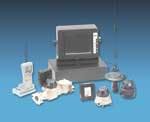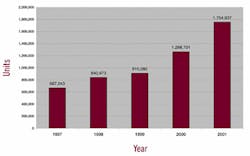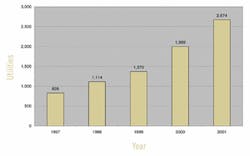Water AMR Makes Tremendous Strides in the Past Decade
By Maritza Jackson
In 1991 Alexander and Associates published a study called Meter Reading High Technology Products for Water, Gas and Electric Utilities. Looking back on the publication more than a decade later, it's interesting to see what has changed and what has remained the same.
The author of the study predicted that $100 million would be spent on meter reading technology in 1991. He also reported that 70 percent of large U.S. utilities, defined as those with more than 10,000 meters, had installed meter-reading devices that were read with handheld computers.
Some interesting comments in the study include the notion that fully automatic meter-reading systems were too costly for most small and mid-size utilities. The author based this view on a typical calculation of payback for Automatic Meter Reading (AMR) in the 10-year range. He also recommended that gas, water and electric utilities combine meter-reading operations. AMR technologies listed were dial-inbound, dial-outbound and a generalized category of radio frequency that included a description of mobile radio frequency (RF) technology.
We can compare these opinions from over a decade ago with AMR activity today in the North American water industry.
In 2001 approximately 1.7 million AMR units were shipped to almost 2,800 water utilities, according to the most recent edition of The Scott Report on AMR Deployments, published by Cognyst Consulting LLC. These installations bring the total number of AMR units at water utilities to over 6.8 million, a saturation rate of about 12 percent.
Though this figure may seem to be a small portion of the 55 to 60 million water meters in North America, it correlates well with the early-adopter segment of most technology markets. As the technology moves from the early-adopter to the early-majority stage, these numbers should increase at a rapid pace. In fact, the Scott Report indicates that the pace of installations in 2001 was close to the record pace set in 2000.
And despite the 1991 prediction, many small and mid-size water utilities have built strong business models justifying the deployment of AMR, then installed the systems and found them to be cost-effective. In fact, more AMR systems are installed at water utilities with less than 25,000 meters than at water utilities with more than 125,000 meters.
This phenomenon is caused partially by the distribution of water utilities. The American Water Works Assoc. reports that about 3,000 U.S. water utilities serve populations of more than 25,000. The remaining 52,000 U.S. water utilities serve populations of less than 25,000. Total annual shipments to water utilities have maintained their growth rate better than those to either electric or gas utilities, partially because of the large number of smaller systems.
AMR Success Stories
In the city of Billing Heights, MT, which serves more than 10,000 residents, a mobile-radio AMR system reduced meter reading time from 168 hours per month to eight hours per month. During the deployment process, utility managers realized AMR's impact on cost savings and sped up the planned five-year installation, finishing only two years after the project began.
The AMR system in the city of Euless, Texas, paid for itself quickly because of increased revenue. The city provides water for 43,000 people. Before AMR, unaccounted-for water typically was 15 percent. Now, with new meters and AMR, the city bills for 96 percent of all water released into the distribution system.
Large cities also benefit from AMR. Philadelphia Water Department installed an AMR system looking for a payback in improved customer service, and results are even more impressive than anyone expected. With AMR, PWD provides actual monthly reads to 99.5 percent of its customers. Previously, actual reads were only attempted every three months. An additional benefit is that customer service calls have decreased by 20 percent. The massive installation was completed in less than two years so all customers could enjoy the enhanced level of service.
Even utilities that have low perceived meter-reading costs can justify AMR installation. When the Federal District of Mexico privatized its water system, many felt that meter-reading costs were too low to consider investing in remote metering technologies. However, leaders at Aqua de Mexico chose to install AMR in that utility's section of the city and has found numerous returns on the investment including reduced meter tampering and increased data security to allow for proper preparation of bills.
Many business factors beyond basic meter-reading savings can justify investing in AMR. Examples include offering customized billing dates, guaranteeing meter-reading accuracy and providing consolidated billing for customers with multiple accounts. When project managers incorporate all the areas where savings, avoided costs and new revenue can be calculated, any size water utility can see the logic of installing AMR.
Deployment activities at water utilities across North America and around the world have increased dramatically in the past couple of years, and analysts expect this trend to continue. Why? Because in the majority of cases, the benefits of AMR can exceed utility leaders' expectations.
AMR Opportunities
AMR technologies have increased exponentially compared with the three listed in the 1991 study. At the AMRA 2002 International Symposium, 100 vendors will display AMR products and services. Technologies include two-way telephone devices, satellite systems, using the Internet and everything in between.
Installations of RF AMR have increased not only in units shipped, but also in the number of technology choices and companies that provide them. Meter readers can use RF for walk-by or drive-by meter reads, and fixed-network systems can relay usage data over various wireless networks with no human intervention at all.
The 1997 Scott Report on AMR Deployments, which was the first, listed seven vendors of RF technology. Today that list has grown to 23 vendors with different communication types. More than 80 percent of the total number of AMR units installed use RF technology. This RF proliferation creates opportunities for water utilities.
Utilities that install fixed-network AMR can do much more than collect a monthly meter read for billing. And collecting more frequent reads can lead to increased revenue.
For example, St. Louis, MO County Water has 33 large meters that supply water to neighboring utilities, and these meters require daily reads to ensure billing records are accurate. Previously, employees had to drive to all 33 locations every day to collect meter reads.
But after an adjoining utility installed fixed-network AMR, St. Louis County Water could get meter reads at 15-minute intervals. Reduced labor cost partially justified the AMR installation, and the adjoining utility was able to secure a new revenue source.
The increase in AMR technologies also enables water utilities to resell what once was of interest only to them. Large water users including hotels, irrigation systems and chemical process plants will pay for the ability to access meter-reading data on demand. That dripping faucet that keeps you awake in the hotel is more than an irritant. To hotel owners it's a controllable expense - if they know the leak is occurring.
Water utilities can use technologies that provide limited access to customized consumption information through the Internet. This revenue stream potential probably isn't one that water-utility executives would have envisioned in 1991.
In the past 11 years, the AMR industry has seen many changes. Technology choices have expanded from three basic technologies to multiple RF, telephone, power line carrier and hybrid systems. For water utilities that want to remain economically viable, AMR makes perfect sense.
About the Author:
Maritza Jackson is director of business development at Badger Meter Inc., based in Milwaukee. She also is president elect of AMRA. Contact Jackson at [email protected]. This article also appeared in the 2001 edition of Utilities Management Solutions, published by Sterling Publications Ltd.



